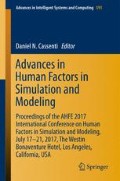Abstract
NASA’s Resource Prospector mission is an unmanned lunar exploration mission currently in the concept development stage. Early tests have shown that the unique mission characteristics may combine to create the potential for very high workload for operators. This paper applies a taxonomy of workload drivers to identify the contextual variables expected to contribute to operator workload during the mission. Specifically, workload drivers attributed to the environment, task demands, equipment, and operator characteristics are reviewed. This research is intended to support the development of predictive models of operator workload to support the design and evaluation of workload countermeasures for the mission.
Access this chapter
Tax calculation will be finalised at checkout
Purchases are for personal use only
References
Andrews, D., Colaprete, A., Quinn, J., Bluethmann, B., Trimble, J.: Resource Prospector (RP) - early prototyping and development. In: AIAA Space 2015, Pasadena, CA, pp. 779–793 (2015)
Pedersen, L., Han, C.S., Vitus, M.: Dark navigation: sensing and rover navigation in permanently shadowed lunar craters. In: 9th i-SAIRAS, Los Angeles, CA (2008)
Trimble, J., Carvalho, R.: Lunar prospecting: searching for volatiles at the south pole. In: SpaceOps 2016 Conference, Daejeon, Korea, pp. 2272–2280 (2016)
Trimble, J., Shirley, M.H., Hobart, S.G.: Agile: from software to mission system. In: SpaceOps 2016, Daejeon, Korea, pp. 1012–1019 (2016)
Yoshida, K., Wilcox, B.: Space robots and systems. In: Khatib, O., Siciliano, B. (eds.) Springer Handbook of Robotics, pp. 1031–1063. Springer, Heidelberg (2008)
Gingras, D.: Deployment of the CSA Teleoperation Robotic Testbed 2 at Rougemont Sand Quarry. Test report, Canadian Space Agency (2014)
Hart, S.G.: NASA-Task Load Index (NASA-TLX); 20 years later. In: Proceedings of HFES, Los Angeles, CA, vol. 50, no. 9, pp. 904–908 (2006)
Hooey, B.L., Kaber, D.B., Adams, J.A., Fong, T., Gore, B.F.: The Underpinnings of Workload in Unmanned Vehicle Systems. IEEE Trans. Human–Mach. Syst. (2018, in press)
Vertesi, J.: Seeing Like a Rover: How Robots, Teams, and Images Craft Knowledge of Mars. University of Chicago Press, Chicago (2015)
Liu, D., Peterson, T., Vincenzi, D., Doherty, S.: Effect of time pressure and target uncertainty on human operator performance and workload for autonomous unmanned aerial systems. Int. J. Ind. Ergon. 51, 52–58 (2016)
da Silva, F., Scott, S., Cummings, M.: Design methodology for Unmanned Aerial Vehicles (UAV) team coordination. Technical report HAL2007-04, MIT (2007)
McGovern, D.E.: Experience and results in teleoperation of land vehicles. In: Ellis, S. (ed.) Pictorial Communication in Virtual and Real Environments, pp. 182–195. Taylor and Francis, Bristol (1991)
McGovern, D.E.: Human interfaces in remote driving. Technical report SAND88-0562, Sandia National Laboratory (1988)
Pastore, T.H.: Improved operator awareness of teleoperated land vehicle attitude. Technical report NRAD-TR-1659, Naval Command, Control, and Ocean Surveillance Center, San Diego, CA (1994)
Chen, J.Y.C., Durlach, P.J., Sloan, J.A., Bowens, L.D.: Robotic operator performance in simulated reconnaissance missions. Technical report ARL-TR-3628, Hum. Res. Eng. Dir., Army Research Laboratory, Aberdeen Proving Ground, MD (2005)
Voshell, M.G., Woods, D.D.: Breaking the keyhole in human–robot coordination: method and evaluation. In: Proceedings of HFES, vol. 49, pp. 442–446, Orlando, FL (2005)
McCarley, J.S., Wickens, C.D.: Human factors concerns in UAV flight. Technical report AHFD-05-05/FAA-05-01, University of Illinois at Urbana-Champaign Institute of Aviation, Savoy, IL (2005)
Chen, J.Y.C., Haas, E.C., Barnes, M.J.: Human performance issues and user interface design for teleoperated robots. IEEE Trans. Syst. Man Cybern.-C: Appl. 37(6), 1231–1245 (2007). IEEE Press
French, J., Ghirardelli, T.G., Swoboda, J.: The effect of bandwidth on operator control of an unmanned ground vehicle. In: Proceedings of the I/ITSEC, Orlando, FL (2003)
Chen, J.Y.C., Barnes, M.J.: Human-agent teaming for multirobot control: a review of human factors issues. IEEE Trans. Hum.-Mach. Syst. 44(1), 13–29 (2014). IEEE Press
Kress, G., Almaula, H.: Sensorimotor requirements for teleoperation. Report R-6279, FMC Corporation, Santa Clara, CA (1988)
Szalma, J.L.: Individual differences in human-technology interaction: incorporating variation in human characteristics into human factors and ergonomics research and design. Theoret. Issues Ergon. Sci. 10(5), 381–397 (2009)
Lathan, C.E., Tracey, M.: The effect of operator spatial perception and sensory feedback on human-robot teleoperation performance. Presence: Teleoper. Virtual Environ. 11(4), 368–377 (2002). MIT Press
Rodes, W., Gugerty, L.: Effects of electronic map displays and individual differences in ability on navigation performance. Hum. Factors 54(4), 589–599 (2012)
Baber, C., Morin, C., Parekh, M., Cahillane, M., Houghton, R.J.: Multimodal control of sensors on multiple simulated unmanned vehicles. Ergonomics 54(9), 792–805 (2011)
Chen, J.Y.C.: Concurrent performance of military and robotics tasks and effects of cueing in a simulated multi-tasking environment. Presence: Teleoper. Virtual Environ. 18(1), 1–15 (2009)
Gore, B.F., Hooey, B.L., Haan, N., Bakowski, D.L., Mahlstedt, E.: A methodical approach for developing valid human performance models of flight deck operations. In: Kurosu, M. (ed.) 14th Annual Human Centered Design Conference, pp. 379–388. Springer, Heidelberg (2011)
Gore, B.F.: Workload as a performance shaping factor for human performance models. In: 20th BRIMS, Sundance, UT (2011)
Acknowledgments
We would like to thank the members of the Resource Prospector mission team who have shared their insights and experiences including Mark Allan, Matt Deans, Michael Furlong, Mark Shirley, and Vinh To. Also, we would like to thank Mark Micire, Eric Krotkov, and John Paschkewitz for motivating and encouraging this study as part of an effort to model and predict workload in human-machine systems.
Author information
Authors and Affiliations
Corresponding author
Editor information
Editors and Affiliations
Rights and permissions
Copyright information
© 2018 Springer International Publishing AG (outside the USA)
About this paper
Cite this paper
Hooey, B.L., Toy, J.J.N.T., Carvalho, R.E., Fong, T., Gore, B.F. (2018). Modeling Operator Workload for the Resource Prospector Lunar Rover Mission. In: Cassenti, D. (eds) Advances in Human Factors in Simulation and Modeling. AHFE 2017. Advances in Intelligent Systems and Computing, vol 591. Springer, Cham. https://doi.org/10.1007/978-3-319-60591-3_17
Download citation
DOI: https://doi.org/10.1007/978-3-319-60591-3_17
Published:
Publisher Name: Springer, Cham
Print ISBN: 978-3-319-60590-6
Online ISBN: 978-3-319-60591-3
eBook Packages: EngineeringEngineering (R0)

